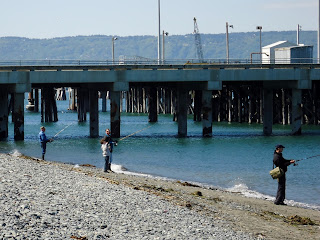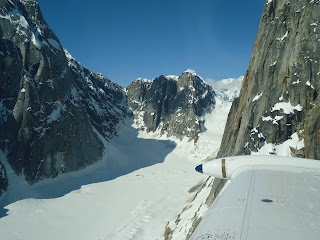The Homer airport with the Pacific Ocean in the distance.
Because we were busy flying in and out, we didn't get to spend as much time there as we might have liked, but we did manage to get out on the Homer Spit, which is 4.5 miles long and extends out into the Kachemak Bay, and is home to the commercial harbor.
Homer Spit from the plane coming in for landing
Besides being the hub of fishing activity,
and a cool place to view marine wildlife . . .
(Those brown dots are actually sea otters lazing around, a whole raft of them, in fact.)
. . . it is also home to the infamous Salty Dawg Saloon.
The Salty Dawg Saloon (exterior)
The Salty Dawg (interior) with the excellent and very friendly bartender, B.J., working the taps.
(Just don't ask him to make a Bloody Mary, no matter how fantastic the locals tell you it is! It drives him crazy because it sets off a run of orders that takes him forever to clear.)
While talking to fellow tourists, pilots (one of which Ward knew, which also goes to show what a small world this is), and local fisherman we found out the patron-supplied decor used to be much more extensive, but they had to take it all down to paint the walls and only got a portion of the collection back up. There are still lots of dollar bills signed by visitors from around the world, but the best find to my mind was the Minnesota license plate that said POLICE. B.J. wasn't exactly clear on how it got there (not wanting to incriminate anyone) but he did confirm it came from Minneapolis.
On our second pass through we stopped at the excellent Islands and Oceans Visitor Center, where they had a temporary exhibit on World War II in Alaska, as well as permanent exhibits on indigenous wildlife and the environmental efforts to protect them. We never made it into town during the day, which I'm told has a real artistic vibe, but after dinner we did get a chance to stroll Bishop's Beach, where one can find beautiful, semi-polished rocks brought down by the glaciers as well as naturally occurring coal chunks.
My only regret is we were too early in the season to catch the salmon run, but there's always next time . . .






















































